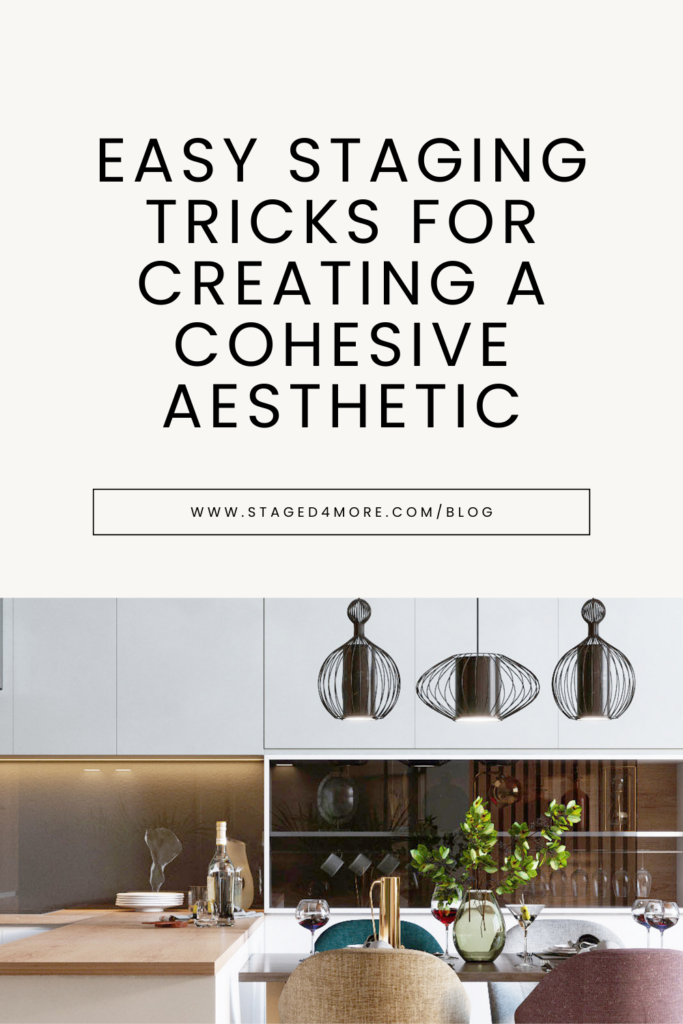Easy Staging Tricks for Creating a Cohesive Aesthetic
Hey there!
I'm Cindy
Founder of Staged4more.
This blog post is written by a contributor, who is credited at the end of this blog post.

Home staging often feels like piecing together a puzzle. Each room presents its challenges — without the right approach, even the most beautiful spaces can seem disjointed.
Achieving a cohesive aesthetic is the key to making every piece fit seamlessly, ensuring potential buyers instantly feel connected to the space. Here’s how to turn any home into a harmonious haven that resonates with viewers.
Use the Subtlety of Neutrals
Neutral colors serve as the unsung heroes in home staging. They act as a canvas, setting the stage for various design elements to shine.
For instance, homes with midtone rosy brown front doors sell for nearly $300 more than black or gray ones. This underscores earth tones’ appeal and potential financial benefit in home staging.
When selecting neutrals, it’s essential to consider the room’s lighting and size. For instance, a smaller space might benefit from lighter shades like off-white or soft gray to make it appear more spacious.
On the other hand, larger rooms can handle deeper neutrals like charcoal or mocha, adding a touch of sophistication. You can even use peel-and-stick wallpaper to spice up your room color without making a major commitment.
Blend Different Styles
Staging a home isn’t about rigidly adhering to one design style — it’s about creating a unique and universally appealing space.
More than 80% of buyers’ agents said staging a home made it easier for a buyer to visualize the property as a future home. This visualization becomes more accessible when the space feels familiar and fresh.
For example, combining the clean lines of contemporary design with the warmth of farmhouse elements can create a balanced and inviting space. A sleek, modern sofa paired with a rustic wooden coffee table can strike the perfect balance.
When blending styles, start with a neutral base. This allows for more flexibility in mixing and matching furniture and decor.
A consistent color scheme throughout the space is also recommended to ensure that even contrasting elements feel connected and cohesive.
Embrace Textures and Layers
Textures and layers to stage a home are essential in creating a luxurious and lived-in space.
Hardwood floors provide a smooth and polished look. However, layering a plush, soft rug over them instantly adds warmth and comfort. Similarly, a leather sofa might exude sophistication, but velvet cushions add a coziness that beckons potential buyers to sit and stay awhile.
Always consider the space’s primary function. Soft linens and plush pillows take center stage in a bedroom, while in a living room, a mix of smooth surfaces and tactile accessories can strike the right balance.
Let Nature In
The benefits of integrating natural elements into interior design are well-documented. Spaces that incorporate natural elements can increase well-being by 15%.
The farmhouse style, with its nature-inspired hues, evokes warmth and nostalgia. On the other hand, the midcentury modern aesthetic, with its emphasis on indoor-outdoor living, reminds of the seamless connection with the surroundings.
Place potted indoor plants in strategic locations when staging a room. They add a touch of green and improve air quality. Wooden accessories, like trays or candle holders, can introduce an earthy feel.
Focus on Flow and Functionality
Flow and functionality create a living space that looks good and works well for everyday life. Visualization is easier when it has a logical flow.
Position furniture in a way that allows for easy movement. Create distinct zones for different activities, like a reading nook or a coffee corner, but ensure they blend seamlessly with the overall design.
You can also keep some areas open. Overcrowding a room can make it feel smaller and disrupt the natural flow.
Highlight Key Features
Every home has unique features that make it stand out: a cozy fireplace, a bay window with a view or exposed brickwork that adds an industrial flair.
For instance, you can use accent lighting to draw attention to unique architectural features and choose complementing decor. If you have a beautiful fireplace, stage it with tasteful mantel decorations.
Consistency Is Key
Consistency in design ensures that the home feels unified from room to room, creating a harmonious experience for potential buyers.
Homes staged before listing receive offers 87% faster than those staged post-listing. Consistency plays a significant role in this.
Stick to a consistent color palette throughout the home. It doesn’t have to be monochromatic, but the shades should complement each other.
If you’re using a specific design style, ensure elements of it appear in each room, even if subtly. Pay attention to hallways and corridors. These transitional spaces should also reflect the home’s overall design theme.
Crafting a Seamless Home Experience
The stakes are high in the home staging game. A disjointed or poorly staged house can linger on the market, while a well-staged one can sell faster and at a higher price point.
Creating a cohesive aesthetic in home staging blends artistry and practicality. It’s not just about making a space look good — it’s about making it functional and inviting.
Remember, the ultimate goal is to make the buyer feel at home, to see themselves living in the space you’ve so carefully curated. Create a harmonious environment that catches the eye and captures the heart.

This post is contributed by Evelyn Long, who is a writer and the editor-in-chief of Renovated. Her work has been published by the National Association of Realtors, McKissock, and other online publications.
What Are You Looking For?
Company
About
Join the School
Events
Podcast
Home Stager Directory
International Home Staging Awards
StagerCon 2023
Subscribe to our newsletter
Contact
Student Log-In
Teach on Staged4more
Terms & Privacy Policy
Affiliate Disclosure
Contribute & Ads
Sponsorship
Join Us
FAQs
Become an Ambassador
Contact
Website Design by Local Creative
© 2025 Staged4more. All Rights Reserved